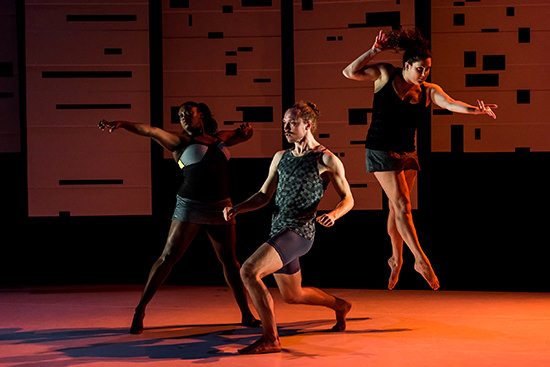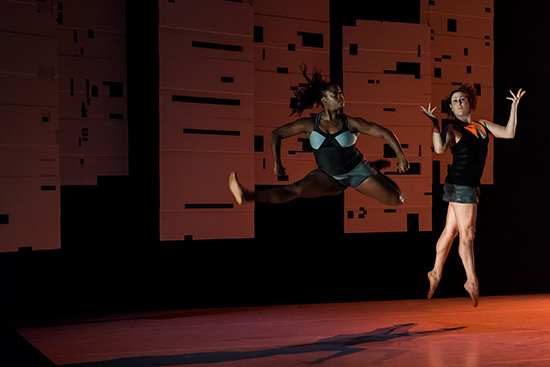Fraught organic/digital business
Ben Brooker: Larissa McGowan, Mortal Condition

Mortal Condition
photo Daniel Purvis
Mortal Condition
When I interviewed Larissa McGowan about her new dance work, Mortal Condition, the dancer and choreographer quoted YouTube video tutorial maker Evan Puschak’s conceptual account of the virtual world of video games: “A meditation both on the unspoiled image of what we want, and its profound unsatisfactory reflection—what we are.” Introduced into the work’s development process by dramaturg Steve Mayhew, Puschak’s idea fed into Mortal Condition’s bipartite nature and remains pivotal to the finished work, which is divided into two distinct halves, titled Condition and Mortal Condition.
The first part, sound-tracked by the short, guttural vocal improvisations of Mike Patton’s 1996 album Adult Themes for Voice, is a duet between McGowan and Thomas Bradley, which interprets Patton’s electronically processed squeals, growls and rapid-fire jabbering as a series of miniature vignettes that evoke basic human interactions: fighting and love-making, casual greetings and aggressive separations.
There is no pretense at fluidity: each eruption of movement, hard and fast, is synchronised precisely to the Patton tracks, many of which are less than a minute long, and the dancers simply pause in between each, their breathing heavy in the silences as they wring the sweat out of their retro video game T-shirts. There is a disquieting sense in which they are being danced by, rather than dancing to, the recorded vocalisations, especially when their mouths yawn widely or frantically open and close in a nightmarish form of lip-synching. Bodily too, there seems to be a loss of control, limbs flung out to lead wildly gyrating torsos in short, demented arcs.
Nevertheless, the robust physicality of McGowan’s choreography is, characteristically, shot through with humour, the dancers often exchanging puzzled glances in between the vignettes as if to say, “What on earth are you doing that for?” There’s also an emphasis on taboo bodily functions—one of Patton’s tracks is titled “A Smile, A Slap in the Face, A Fart, A Kiss on the Mouth”—that manifests in gestures that resemble vomiting and furious, exorcism-like purges of the body. The dancers’ athleticism is unwavering as they continuously rise, fall and roll across designer Toby K’s rectangular, off-centred floorcloth, which, in its radiant whiteness, produces stage images of sharp relief.
The earthy preoccupations of the first part are contrasted with the second, which plunges McGowan and Bradley—now joined by Kialea-Nadine Williams—into the digital world. The casual T-shirts and track pants of the first half are traded for quasi-militaristic garb that recalls iconic video game character Lara Croft, while Bradley is reconfigured as the archetypal gamer, hunched over an imagined controller in a corner of the stage. Seven white banners suspended along the back of the theatre, a dozen or so squares punched out in each like a microchip or early video game cartridge, swing to face the audience, Toby K’s projection design emblazoning them with crude, pixilated icons of humanoid figures and a variety of weapons in the manner of a game user interface. Patton’s soundtrack is substituted for an original score by DJ Tr!p, which draws on the blippy simplicity of video game music from the 8- and 16-bit eras, as well as the increasingly cinematic lushness of contemporary soundtracks to games such as World of Warcraft.

Mortal Condition
photo Daniel Purvis
Mortal Condition
As in the first half, the interactions of the dancers—proximal but often contactless—can be read as explorations of human power dynamics, but here these are complicated by their gendered nature, McGowan and Williams the subjects of Bradley’s gaze. In the first sequence, the mechanics of a car-making game are invoked, a male voice-over dully intoning the attributes of a fantasy sports car while McGowan and Williams ‘model’ the vehicle using their bodies. This dynamic is later reversed as Bradley appears to corporeally transition into the virtual world where, as in a massively multiplayer online game, he slugs it out with McGowan and Williams, each cycling through a vast inventory of weapons—these depicted in increasingly rapid succession in the projections while the dancers contort their arms and bodies into the appropriate shape. He is ultimately vanquished.
Trading oppositions between the organic and the digital can be a fraught business in contemporary performance, establishing arbitrary hierarchies of value and disallowing that the relationship between the two is almost always a fluid and interdependent one. Perhaps this is why Mortal Condition felt, for me, weakened by its binary structure, the correlation between the halves too elusive to provide a fully satisfying conceptual framework. The design is similarly misconceived, especially in the second part where, curiously unintegrated with the dancers, its effect seems largely cosmetic. It’s not clear, finally, what the desiring, rapacious bodies of the first part’s corporeal world see in their virtual reflections, or whether, in looking back, the ‘unspoiled image’ contains within it the power to alter their—and, by extension, our—reality.
–
Mortal Condition, concept, choreography Larissa McGowan, associate director, dramaturg Steve Mayhew, dancers Thomas Bradley, Larissa McGowan, Kialea-Nadine Williams, composer DJ Tr!p, lighting, projection designer Toby K; Space Theatre, Adelaide Festival Centre, 11-14 May
RealTime issue #133 June-July 2016






